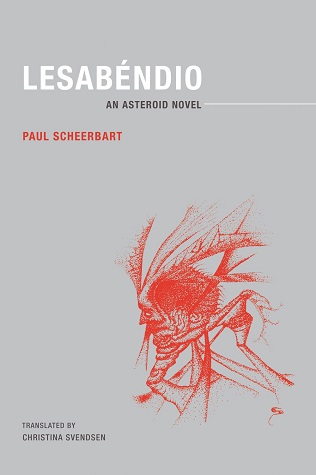
by by Margaret Kolb

Published by Wakefield Press, 2012 | 28o pages
Paul Scheerbart’s Lesabéndio opens with a conversation between the title character and his friend, Biba. The elderly Biba writes philosophical books on transcendence and eccentricity. In this opening conversation, Biba confesses to his friend his desire to visit the sun. Lesabéndio wisely talks him out of the journey, reminding his friend that Pallas, their home asteroid—replete with conveyor belt highway systems, towering crystal sculptures, and an overhanging giant light cloud made of strands as thin as spider’s silk—is already a fantastical and mysterious place. Indeed, Lesabéndio is himself in the grip of a powerful obsession with Pallas, and in particular with that which lies beyond its polar light cloud, an obsession that will lead him to undertake an immense labor to utterly transform the Pallasian landscape and society in pursuit of his own dream of transcendence.
Lesabéndio, first published in 1913 and translated here by Christina Svendsen—who also provides a helpful introduction—is a peculiar work of science fiction. The world of Lesabéndio is similar to ours in ways, though distorted as if in parallax: the setting is a solar system where planets are conflated with stars, and the physical, cosmological, and biological laws governing the world are frequently quite alien. Just as Scheerbart explores diverse physical systems, so he uses this setting to explore alien politics and culture. Scheerbart paints Lesabéndio’s setting, Pallas, with astonishing imagination and detail. The asteroid itself is a torus (donut) shaped satellite within a larger system of asteroids in orbit around a planet named Jupiter (again, it is crucial to keep in mind that the setting of Lesabéndio is both the solar system in which we live and not). Pallasians refer to the surface entrances into the hole that runs for a half mile straight through their asteroid as the north and south funnels. All of Pallasian life happens on the mountainous and cavernous surface of these inner funnels. Pallas is too far from the sun to receive adequate energy from it; instead it receives its light and energy from a mysterious cloud that hovers above Pallas’s northern funnel. The cloud rhythmically progresses from bright to dark to bright again, creating days and nights that each last the equivalent of an Earth month. Though it has regular patterns, the light cloud’s mechanisms are shrouded in mystery. It is unknown how it produces its light or why it seems to exert an anti-gravitational force on the civilization that lives beneath it.
Despite their craggy, arid appearance of the Pallasian landscape, the reptilian-bodied Pallasians live unburdened by the most basic human worries. Their diets are comprised solely of the mushrooms that bloom sustainably across Pallas. New Pallasians are born when stone-like nuts buried deep in Pallas’s interior valleys are mined and cracked open. Newly born Pallasians emerge out of these stones fully formed, well-socialized, and with memories of transcendental journeys undertaken before their birth. To sleep, the Pallasians stretch their skins to form balloon sacks and smoke a bubble-weed that grows from one of their arms. This weed purifies them and makes them glow. As they drift to sleep, the glow dissipates. Pallasians decide when it is their time to die, and the dying process involves one Pallasian simply absorbing the body and persona of the deceased. War is unknown on Pallas, and the Pallasians wile away their time designing grandiose projects for renovating their home planetoid. Traveling deep into Pallas’s core via the asteroid’s conveyor belt highway, we encounter immense architectural interventions that range from mountain-length crystalline facades to giant balloon sculptures to towers of skins that create symphonies with the solar winds blowing through Pallas’s central funnels. A cast of Pallasian architects design these works in the caverns of Pallas’s rocky surface, which are then produced by unnamed masses of laborers.
At the center of Scheerbart’s novel is Lesabéndio, an ambitious Pallasian obsessed with his vision of building a massive tower to penetrate the mysterious light cloud floating above Pallas’s northern pole. Lesabéndio’s design will have the tower extending 44 miles from the northern funnel through the light cloud and into, he believes, transcendence. Biba, Lesabéndio’s philosopher friend, understands the novel’s protagonist deeply. Biba tells him, “You don’t ever want to be absorbed by another Pallasian. No, you want to be absorbed up there in the great system of the comets—and become a comet yourself.” Lesabéndio admits that he is “driven—by unknown powers—always straight ahead—up to the heavens.”
The quest for transcendence—the search for something beyond the limits conditioning one’s whole existence—is a familiar archetype of Western culture dating back at least to The Epic of Gilgamesh. Scheerbart colors his version of this quest with the aesthetic and political questions pervading the thought of his day. Lesabéndio’s project comes with significant costs, including expending almost all of Pallas’s intellectual and natural resources—hatching new workers, growing more mushroom fields, depleting the planet of valuable steel used in its existing infrastructure. In addition, his project threatens the subjugation of masses for the benefit of one. Unsurprisingly, the vast majority of Pallasians protest, especially the aesthetes, who desire only to continue practicing their decorative arts. Scheerbart utilizes a playful and exuberant narrative voice to throw into stark relief the possibility that Lesabéndio’s utopia may in fact create a dystopia for his fellow inhabitants. Lesabéndio’s bid to win over the aesthete Manesi, for example, falls on deaf ears. Manesi dismisses Lesabéndio short, saying, “Your tower . . . exists for the purpose of new discoveries and not for aesthetic reasons or for the sake of art.”
Lesabéndio eventually convinces his fellow Pallasians of his vision’s soundness—that his tower is the means towards final transcendence—and the entire Pallasian society begins work on the tower’s construction. Here we witness the quiet but flagrant violence Lesabéndio’s project does to Pallas’s unskilled laborers. Shortly after his birth—witnessed firsthand by Lesabéndio—Bombimba speaks for pages about his wondrous journeys and experiences before birth. As the novel and Lesabéndio’s massive construction proceed, Bombimba is gradually written out entirely. His labor and life are, in the final accounting, irrelevant. There is only the tower, the light cloud, and that which lies beyond. Moments such as this show that Lesabéndio’s ample playfulness belies its incisive commentary on industrialization and politics as well as their union’s deleterious effect on aesthetic and individual freedom. In this light Lesabéndio can be seen as proto-fascist figure, willing to risk the existing Pallasian utopia to realize his irrational dream of piercing the light cloud to achieve intellectual transcendence. These precarities, handled so fluently in Scheerbart’s raconteur style, juxtapose the dual, perhaps conflicting, human drives towards industrial progress and individual and aesthetic autonomy.
Due both to this satirical bite and Scheerbart’s masterful and enchanting execution, Lesabéndio covertly but incontrovertibly influenced twentieth and twenty-first century literary, artistic, and critical theories of humanity, industrialism, and aesthetics. Architects including Walter Gropius, Bruno Taut, and Hans Scharoun publicly confessed to being influenced by Scheerbart’s zealous portraits of the utopian prospects of glass architecture, and Walter Benjamin referred to the novel in his Arcades project and even planned to use an extended discussion of the novel for an essay on twentieth century politics.
Near Lesabéndio’s conclusion Lesabéndio’s tower is eventually completed, and he ascends into the mysterious light cloud with some trepidation. He floats in the glow of the same sun he felt so uninterested in when we first met him. Time passes, and we witness Lesabéndio talking to the sun and conversing with the planets. The wisdom they appear to feed him – which valorizes persistence through suffering – he passes down to the Pallasians, who stop working on all other enterprises to explore this new philosophy of life. Enormous numbers die as Lesabéndio’s conversations with the sun and surrounding planets gets more intimate, spiritual, rarefied. But Lesabéndio cannot, or will not, break with the siren song of the sun and planets. The novel ends with the same sun that opened it, radiating brighter and brighter, hinting at the possibility of new life, of planetary extinction, and the uncertain future of Lesabéndio and the individuals living beneath him.
D.H. Varma is a graduate of the MFA in Creative Writing Program at The University of Notre Dame. His fiction has appeared in Oxford American Magazine, Mikrokosmos, Barely South Review, and elsewhere. His works in progress and personal writing can be found at www.pillowfort.space.















click to see who
MAKE Magazine Publisher MAKE Literary Productions Managing Editor Chamandeep Bains Assistant Managing Editor and Web Editor Kenneth Guay Fiction Editor Kamilah Foreman Nonfiction Editor Jessica Anne Poetry Editor Joel Craig Intercambio Poetry Editor Daniel Borzutzky Intercambio Prose Editor Brenda Lozano Latin American Art Portfolio Editor Alejandro Almanza Pereda Reviews Editor Mark Molloy Portfolio Art Editor Sarah Kramer Creative Director Joshua Hauth, Hauthwares Webmaster Johnathan Crawford Proofreader/Copy Editor Sarah Kramer Associate Fiction Editors LC Fiore, Jim Kourlas, Kerstin Schaars Contributing Editors Kyle Beachy, Steffi Drewes, Katie Geha, Kathleen Rooney Social Media Coordinator Jennifer De Poorter
MAKE Literary Productions, NFP Co-directors, Sarah Dodson and Joel Craig